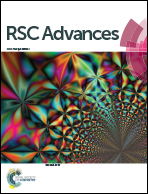Synthesis of poly(2-hydroxyethyl methacrylate-co-acrylic acid)-grafted graphene oxide nanosheets via reversible addition–fragmentation chain transfer polymerization
Abstract
Natural graphite was oxidized via the Hummer's method and sonicated to obtain graphene oxide (GO). A three-step modification process was performed to attach a reversible addition–fragmentation chain transfer (RAFT)-agent onto the GO surface and obtain GO-RAFT nanosheets. RAFT polymerization of 2-hydroxyethyl methacrylate (HEMA) and acrylic acid (AA) was performed by using azobisisobutyronitrile (AIBN) as initiator. After separation of free chains, GO-P(HEMA) and GO-P(HEMA-co-AA) were obtained. Fourier transform infrared (FTIR), thermogravimetric analysis (TGA), X-ray diffraction (XRD) analysis, Raman spectroscopy, proton nuclear magnetic resonance (1H NMR), size exclusion chromatography (SEC), scanning electron microscopy (SEM) and transmission electron microscopy (TEM) were used to characterize the structure of modified nanosheets. These modified nanosheets showed dual pH- and thermo-sensitive properties as measured by UV-visible spectroscopy. Due to the dark nature of GO-P(HEMA) and GO-P(HEMA-co-AA) nanosheets, the UV-visible absorption of their solutions is an effective parameter to examine the stimuli responsive behavior as measured here at different pH (3–12) and temperature (25–55 °C) values. According to the results, UV-visible absorption of GO-P(HEMA) decreases slightly as pH decreases while the decrease is more significant for GO-P(HEMA-co-AA). Also, a lower critical solution temperature (LCST) of 30 and 34 °C is observed for GO-P(HEMA) and GO-P(HEMA-co-AA) nanosheets respectively.


 Please wait while we load your content...
Please wait while we load your content...